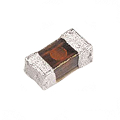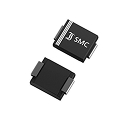Electrostatic discharge (ESD) protection diodes, often called Transient Voltage Suppressors (TVS) diodes, shunt fast voltage spikes away from sensitive circuitry before damage occurs. A single zap can corrupt data, trip resets, or punch through tiny gate oxides, so this small part pays for itself in reliability. Engineers use it on connectors, sensors, buttons, and high-speed ports where the outside world meets silicon. Online Components backs this category with reliable stock, U.S.-based shipping, and an authorized supply chain that gives purchasers confidence at checkout and on the production floor.
Our selection spans single-line devices and multi-line arrays, low-capacitance parts for multi-gigabit links, and uni- or bi-directional geometries for different signal types. Key specifications include reverse standoff voltage (VRWM), clamping voltage at a defined surge, peak pulse current, dynamic resistance, junction capacitance, channel count, and package style from SOT-23 to chip-scale. Many parts carry International Electrotechnical Commission (IEC) 61000-4-2 Edition 3.0 (2025) ratings for contact and air discharges, while automotive-qualified options meet Automotive Electronics Council (AEC)-Q101. You'll find devices with ultra-low leakage for battery-powered gear and rugged parts tested for repeated strikes in harsh environments.
Start with signal integrity. For Universal Serial Bus (USB), High-Definition Multimedia Interface (HDMI), and Serializer/Deserializer (SerDes) links, favor ultra-low capacitance so eye diagrams stay open and jitter stays tame. Next, match VRWM to your operating voltage and pick a clamping level that keeps downstream components inside their absolute maximum ratings during the worst credible discharge. Direction matters: uni-directional suits DC rails and single-ended logic, while bi-directional fits AC-coupled or differential pairs. Last, check footprint, pinout, and a short return path to ground; tight loops improve clamping performance.
Purchasing teams, hardware engineers, compliance testers, and service labs rely on ESD protection diodes whenever a board exposes a pin to human touch, cables, or the environment. Typical placements include data ports, keypad traces, antenna feeds, and sensor lines on enclosures or harnesses. Core application areas include consumer electronics, industrial automation, networking and telecom, automotive modules running Controller Area Network (CAN) or Ethernet, and medical devices with patient-connected interfaces. From handhelds to factory panels, these parts deliver high immunity without heavy cost, heat, or firmware changes.
Online Components offers U.S.-based inventory, fast shipping, and supplier authentication for genuine parts that pass incoming inspection. The site provides clear parametric filters, live availability, and a checkout flow built for speed, so teams can move from spec to cart without friction. Responsive customer service helps validate choices or suggest alternatives when footprints, voltages, or capacitance targets shift late in the cycle. Competitive pricing and friendly minimums support prototypes and production alike.
Use uni-directional for DC rails, GPIO, and single-ended logic where polarity is fixed. Choose bi-directional for differential or AC-coupled interfaces that swing above and below ground.
For SuperSpeed USB, HDMI, and similar multi-gigabit signals, look for single-digit picofarad or sub-pF capacitance. Higher values risk eye closure, added jitter, and compliance failures.
They define test severity for contact and air discharges. Pick parts that meet or exceed your use case, then validate on the final enclosure and cable set to confirm margins.
Yes. Multi-line arrays save space and simplify routing on ports with several data lines, shield, or auxiliary pins, and many include matched channels for balanced pairs.
See More

